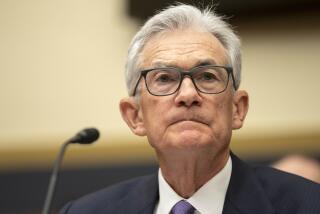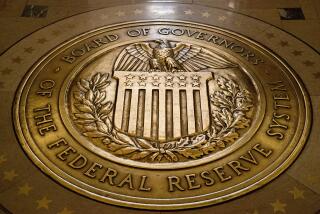Time to declare victory over deflation?
The Federal Reserve’s massive money-printing campaign of the last two years has had one central goal: Make sure the U.S. doesn’t lead the global economy into the black hole of deflation.
It may be time to declare “mission accomplished.”
Around the world, many countries aren’t confronted with the debilitating forces of deflation, or falling prices and wages, but the opposite — inflation. Rising prices, particularly for food, have fueled credit-tightening moves by China, India, Brazil, Australia and other nations in recent months.
Even in Europe, where a government-debt crisis is a serious drag on overall economic growth, annualized inflation in the euro zone rose to 2.2% in December, topping the European Central Bank’s 2% target rate for the first time in more than two years.
In the U.S., a surge in energy prices in December boosted the consumer price index 0.5% from November, the biggest monthly increase since June 2009.
Fed Chairman Ben S. Bernanke last week suggested that the tide had turned in the battle against deflation, saying the risk had “receded considerably.”
Central banks are petrified of deflation because it raises the possibility of a downward economic spiral that can’t easily be reversed. If falling prices result from lack of demand, that could feed on itself, with wages falling as businesses slash costs to survive.
So if Bernanke is right about deflation risks receding, that ought to make people feel more confident about the economic recovery.
“The Fed will be comforted if inflation is rising,” said Dean Maki, chief U.S. economist at Barclays Capital in New York.
Investors, however, have another consideration: how much closer the Fed may be to ending its easy-money policy, and what that would mean for stocks, bonds and other assets.
In emerging markets including China and India, inflation already has become serious enough — running in the mid-to-high single digits — to force governments to act by raising short-term interest rates in an attempt to slow consumer demand.
That has been painful for many emerging-market stock investors. The Shanghai market has slumped 13% since early November; Indian shares have lost 9% in the same period.
Meanwhile, longer-term interest rates have risen worldwide since late summer with inflation concerns, devaluing many fixed-rate bonds. The yield on 30-year U.S. Treasury bonds reached 4.62% on Thursday, a nine-month high and up from 3.5% at the end of August.
Rising inflation erodes fixed-rate returns, so when bond investors fear higher inflation they naturally demand higher yields. That’s also a signal to central banks to step on the brakes.
Yet when Fed officials gather Wednesday for their first meeting of 2011, it won’t be to tighten credit. Instead, they are likely to reaffirm their November commitment to pump $600 billion into the financial system by June via purchases of Treasury bonds, hoping to stoke faster economic growth.
The U.S. may have dodged deflation, but the Fed can argue we’re still skating too close to the edge. As measured by the so-called core consumer price index, which excludes energy and food costs, U.S. prices rose just 0.1% last month and were up a mere 0.8% year over year.
The use of the core CPI as an inflation benchmark has long irked many average Americans. After all, who doesn’t drive a car, heat their home or eat?
Yet even using the full CPI, the Fed has been able to easily defend its cheap-money stance. The CPI overall was up 1.5% last year, a decline from a 2.7% increase in 2009.
Why is official inflation so much worse in emerging-market countries? In large part, it’s because of their greater vulnerability to sharp moves in key commodity costs.
Prices of oil, wheat, cotton, copper and many other raw materials have surged since late summer. They’ve been driven by a combination of rising demand as the global economy has improved, smaller supplies of some grains because of weather-related crop losses, and buying by speculators.
Because poorer people spend a much higher percentage of their income on food than do higher-income people, the effect of soaring grain prices has been magnified in emerging-market countries.
Indians, for example, spend almost half of their income on food. In China, food accounts for about one-third of the consumer price index.
By contrast, food makes up less than 14% of the U.S. CPI.
Moreover, commodity prices typically account for only a small part of the price of packaged foods.
Ian Shepherdson, chief U.S. economist at High Frequency Economics in Valhalla, N.Y., calculates that with wheat at around $8 a bushel, the cost of the grain amounts to just 16.5 cents in a $4.19 loaf of bread at the grocery store. The rest is production, transportation, marketing and profit.
Still, the question is whether higher commodity prices, particularly oil (up 24% since August) could begin to “feed through” to prices of many other U.S. goods and services.
The Fed wants that to happen, to an extent. Policymakers have signaled that they would be much more comfortable about the recovery if the annualized core inflation rate were closer to the 2% level.
But many economists say there are strong forces likely to keep price increases subdued. One is heated competition in a global economy that has plenty of excess production capacity.
What’s more, a glut of labor, with U.S. unemployment at 9.4%, means workers have little power to demand significant raises. That negates the risk of a 1970s-style wage-price spiral, whereby rising wages drive consumption and allow workers to spend freely even as prices increase.
Instead, higher prices for necessities like food and gasoline may force many Americans to sacrifice spending on other things.
In this economy, “When consumers are faced with higher prices they’ll go from Saks Fifth Avenue back to Wal-Mart,” said Bill O’Donnell, bond strategist at RBS Securities in Stamford, Conn.
Yet there are signs that more companies are at least testing the water with price increases.
The Philadelphia Fed branch’s latest economic report on conditions in the mid-Atlantic region showed that its “prices received” index — an indication of manufacturers’ ability to push through price increases — rose this month to the highest level since before the 2008 financial crash.
And with prices of oil and other commodities near two-year highs, it’s virtually certain that more businesses will attempt to pass those higher costs on to customers, says Norbert Ore, who heads the Institute for Supply Management’s business-survey committee.
“They’re all going to try to get a recovery in prices,” he said.
That doesn’t mean the increases will stick. But even the decision to try for price hikes is a sign that the economic recovery has entered a new phase — and that the Fed’s next big concern won’t be how much more stimulus to provide but when to start taking it away.






